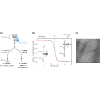Investigation of the cesium activation of GaN photocathodes by low-energy electron microscopy
IF 3.8
2区 物理与天体物理
Q2 PHYSICS, APPLIED
引用次数: 0
Abstract
Low-energy electron microscopy (LEEM) was performed on - samples during in situ cesium deposition. LEEM images of electron reflectivity recorded as a function of the incident electron energy at different coverages allowed to spatially resolve the evolution of the local work function (WF) during the activation process. While the average WF drops by more than 3 eV, the local WF remains quite uniform across the surface throughout the activation process. Maximum fluctuations of less than 0.2 eV were observed in the WF maps for coverage of a fraction of a monolayer. These fluctuations are mainly related to the surface topography, in particular, to the atomic steps’ structure, which replicates the substrate miscut. Apart from these weak spatial fluctuations, no clusters that would induce strong local WF contrast were observed at the scale of the 20-nm resolution of the measurements. These observations agree with the simple model of semiconductor activation to negative electron affinity that describes the formation of a dipole layer as responsible for the lowering of the WF. Additionally, at complete coverage, the WF becomes fully homogeneous over the surface, smoothing out features originating from defects and topography.

利用低能电子显微镜研究氮化镓光电阴极的铯活化情况
在原位铯沉积过程中,对 p-GaN 样品进行了低能电子显微镜 (LEEM)。在不同的铯覆盖率下记录的电子反射率与入射电子能量的函数关系的低能电子显微镜图像可以从空间上解析活化过程中局部功函数(WF)的演变。虽然平均功函数下降了 3 eV 以上,但在整个活化过程中,整个表面的局部功函数仍然相当均匀。在铯覆盖部分单层的情况下,功函数图中观察到的最大波动小于 0.2 eV。这些波动主要与表面形貌有关,特别是与原子阶梯结构有关,它复制了基底的误切。除了这些微弱的空间波动外,在 20 纳米分辨率的测量尺度上没有观察到会引起强烈局部 WF 对比的铯团。这些观察结果与半导体激活负电子亲和力的简单模型一致,该模型描述了偶极层的形成是降低 WF 的原因。此外,在铯完全覆盖的情况下,WF 在表面上变得完全均匀,从而消除了缺陷和地形造成的特征。
本文章由计算机程序翻译,如有差异,请以英文原文为准。
求助全文
约1分钟内获得全文
求助全文
来源期刊

Physical Review Applied
PHYSICS, APPLIED-
CiteScore
7.80
自引率
8.70%
发文量
760
审稿时长
2.5 months
期刊介绍:
Physical Review Applied (PRApplied) publishes high-quality papers that bridge the gap between engineering and physics, and between current and future technologies. PRApplied welcomes papers from both the engineering and physics communities, in academia and industry.
PRApplied focuses on topics including:
Biophysics, bioelectronics, and biomedical engineering,
Device physics,
Electronics,
Technology to harvest, store, and transmit energy, focusing on renewable energy technologies,
Geophysics and space science,
Industrial physics,
Magnetism and spintronics,
Metamaterials,
Microfluidics,
Nonlinear dynamics and pattern formation in natural or manufactured systems,
Nanoscience and nanotechnology,
Optics, optoelectronics, photonics, and photonic devices,
Quantum information processing, both algorithms and hardware,
Soft matter physics, including granular and complex fluids and active matter.
 求助内容:
求助内容: 应助结果提醒方式:
应助结果提醒方式:


